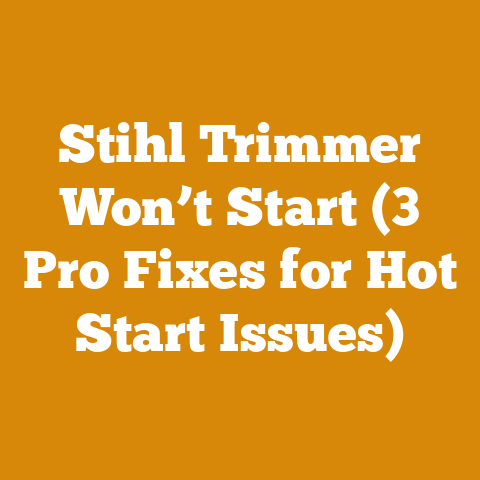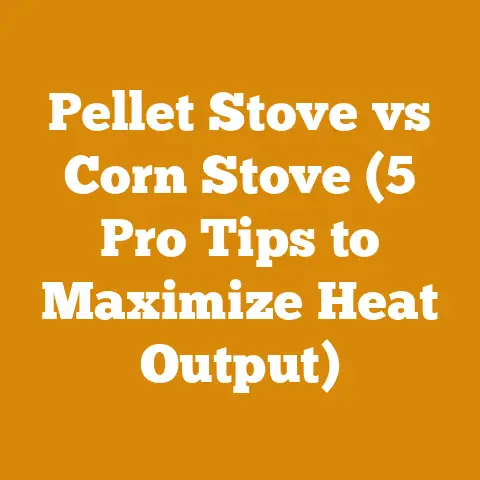England Stove Works 25 PDVC 55 SHP10 Thermostat Guide (Expert Setup Tips)
I’ll never forget the winter of ’08. A sudden cold snap hit, and my old oil furnace decided it had enough. With snow piling up, I knew I needed a reliable heat source, and fast. That’s when I stumbled upon pellet stoves. After a bit of research, I bought an England Stove Works 25-PDVC. It kept my family warm that winter, and I learned a valuable lesson: understanding your stove’s thermostat is crucial. It’s not just about setting a number; it’s about maximizing efficiency, conserving fuel, and keeping your home at the perfect temperature.
Understanding Your England Stove Works Thermostat
The England Stove Works 25-PDVC and 55-SHP10 are popular pellet stoves known for their reliability and ease of use. However, mastering the thermostat can significantly improve their performance and efficiency. Let’s break down the basics.
Thermostat Operation: A Deep Dive
The thermostat on these stoves isn’t just a simple on/off switch. It’s a sophisticated control system that regulates the stove’s heat output based on your desired temperature. Understanding how it works is the first step to optimization.
- Temperature Sensing: The thermostat constantly monitors the room temperature using a sensor. This sensor sends signals to the control board, which then adjusts the stove’s operation accordingly.
- Feed Rate Adjustment: The primary function of the thermostat is to control the feed rate of pellets into the burn pot. A higher thermostat setting signals the control board to increase the feed rate, resulting in more heat. Conversely, a lower setting reduces the feed rate.
- Fan Speed Control: In some models, the thermostat also influences the fan speed. Higher settings may increase the fan speed to distribute heat more quickly, while lower settings reduce fan speed for a gentler heat output.
Decoding the Control Panel
The control panel is your interface with the thermostat. Familiarizing yourself with its components is essential.
- On/Off Switch: This is the basic power control for the stove.
- Heat Range Knob/Buttons: This is your primary temperature control. It usually features a range of settings, often numbered 1 through 5 (or more). Higher numbers correspond to higher heat output.
- Auger Adjustment: The auger is the screw that feeds pellets into the burn pot. Some models have an auger adjustment knob that allows you to fine-tune the feed rate for different pellet types or heating needs.
- Fan Speed Control: Some models offer manual fan speed control, allowing you to adjust the airflow independently of the thermostat setting.
Key Differences Between 25-PDVC and 55-SHP10
While both models share a similar design and functionality, there are some key differences to be aware of:
- BTU Output: The 55-SHP10 typically has a higher BTU output than the 25-PDVC, making it suitable for larger spaces.
- Hopper Capacity: The 55-SHP10 usually has a larger hopper capacity, allowing for longer burn times between refills.
- Control Panel Features: Some variations exist in the control panel layout and features, such as the presence of a manual fan speed control.
Expert Setup Tips for Optimal Performance
Now that we’ve covered the basics, let’s dive into some expert setup tips that will help you get the most out of your England Stove Works pellet stove.
Initial Setup: Laying the Foundation for Success
Proper initial setup is crucial for ensuring long-term performance and efficiency.
- Professional Installation: I always advise having your stove professionally installed. A qualified technician can ensure that the venting is correct, the stove is properly grounded, and all safety regulations are met. This is especially important for first-time pellet stove users.
- Leveling the Stove: Make sure the stove is perfectly level. An unlevel stove can cause uneven pellet feeding and combustion, leading to inefficiencies and potential malfunctions.
- Venting Configuration: The venting configuration is critical for proper draft and combustion. Follow the manufacturer’s recommendations for vent pipe diameter, length, and termination. Avoid sharp bends or obstructions in the vent pipe, as these can restrict airflow.
- Electrical Connection: Ensure the stove is connected to a dedicated electrical circuit with the correct voltage and amperage. This will prevent overloading the circuit and potential electrical hazards.
- First Burn-In: Before using the stove for regular heating, perform a burn-in cycle. This involves running the stove on a low setting for a few hours to allow the components to heat up and burn off any manufacturing residues.
Calibrating the Thermostat: Fine-Tuning for Your Home
Every home is different, and the ideal thermostat settings will vary depending on factors like insulation, window efficiency, and room size. Calibrating the thermostat to your specific needs is essential for optimal comfort and efficiency.
- Start with the Basics: Begin by setting the thermostat to a comfortable temperature, such as 70°F (21°C). Monitor the room temperature over several hours and adjust the thermostat setting accordingly.
- Use a Separate Thermometer: Place a separate thermometer in the room to verify the accuracy of the stove’s thermostat. If there’s a significant discrepancy, you may need to adjust the thermostat’s internal calibration (if your model allows).
- Experiment with Different Settings: Don’t be afraid to experiment with different thermostat settings to find the sweet spot for your home. Keep a log of your settings and the corresponding room temperatures to track your progress.
- Consider External Factors: Account for external factors like outdoor temperature and sunlight. On colder days, you may need to increase the thermostat setting to maintain a comfortable indoor temperature. On sunny days, you may be able to lower the setting.
- Adjust for Occupancy: Adjust the thermostat settings based on your occupancy schedule. If you’re away from home during the day, you can lower the thermostat to conserve fuel. When you return, you can increase the setting to quickly warm up the house.
Optimizing Pellet Feed Rate: The Key to Efficiency
The pellet feed rate is a critical factor in determining the stove’s efficiency and heat output. Optimizing the feed rate can save you money on fuel and improve the stove’s overall performance.
- Match Pellets to Settings: Different types of pellets have different BTU content and burn characteristics. Adjust the feed rate accordingly. Hardwood pellets typically require a lower feed rate than softwood pellets.
- Observe the Flame: The flame should be bright and steady, with no excessive smoke or soot. If the flame is weak or flickering, increase the feed rate. If the flame is smoky or produces excessive soot, decrease the feed rate.
- Monitor Ash Accumulation: Excessive ash accumulation can indicate an inefficient burn. If you’re noticing a lot of ash, try reducing the feed rate.
- Adjust Auger Settings (If Available): Some models have an auger adjustment knob that allows you to fine-tune the feed rate. Consult your owner’s manual for instructions on how to adjust the auger settings.
- Clean Regularly: Regular cleaning is essential for maintaining optimal pellet feed rate. Ash and debris can clog the auger and burn pot, restricting airflow and reducing efficiency.
Fine-Tuning Airflow: Achieving the Perfect Burn
Airflow is just as important as fuel in the combustion process. Proper airflow ensures a clean and efficient burn.
- Check Air Intake: Make sure the air intake is clear of obstructions. Dust, debris, or even snow can block the air intake and restrict airflow.
- Adjust Air Wash: Most pellet stoves have an air wash system that directs a stream of air across the glass door to keep it clean. Adjust the air wash to optimize visibility and prevent soot buildup on the glass.
- Monitor Exhaust: The exhaust should be clear and odorless. If you notice excessive smoke or a strong odor, it could indicate a problem with airflow or combustion.
- Clean Venting: Regularly clean the venting system to remove any ash or creosote buildup. This will ensure proper draft and prevent potential fire hazards.
- Consider a Barometric Damper: In some cases, a barometric damper can help regulate airflow and improve combustion efficiency. A barometric damper is a device that automatically adjusts the airflow based on changes in atmospheric pressure.
Troubleshooting Common Thermostat Issues
Even with proper setup and maintenance, thermostat issues can sometimes arise. Here are some common problems and how to troubleshoot them.
Stove Not Heating: Diagnosing the Problem
If your stove isn’t heating, the first step is to diagnose the problem.
- Check Power Supply: Make sure the stove is plugged in and the circuit breaker is not tripped.
- Verify Thermostat Setting: Ensure the thermostat is set to a temperature higher than the current room temperature.
- Inspect Igniter: The igniter is responsible for starting the fire. If the igniter is faulty, the stove won’t heat up. You can usually visually inspect the igniter for damage or test it with a multimeter.
- Check Auger Motor: The auger motor feeds pellets into the burn pot. If the auger motor is not working, the stove won’t heat up. You can usually hear the auger motor running when the stove is in operation.
- Inspect Combustion Fan: The combustion fan provides air for combustion. If the combustion fan is not working, the stove won’t heat up properly. You can usually hear the combustion fan running when the stove is in operation.
Stove Overheating: Preventing a Dangerous Situation
Overheating can be a dangerous situation. If your stove is overheating, take immediate action.
- Reduce Thermostat Setting: Immediately reduce the thermostat setting to the lowest level.
- Turn Off Stove: If the stove continues to overheat, turn it off completely.
- Check for Obstructions: Inspect the venting system for any obstructions that may be restricting airflow.
- Clean Stove: Clean the stove thoroughly to remove any ash or debris that may be contributing to the overheating.
- Consult a Professional: If the problem persists, consult a qualified technician for further diagnosis and repair.
Erratic Temperature Swings: Maintaining a Consistent Heat
Erratic temperature swings can be uncomfortable and inefficient. Here’s how to address them.
- Calibrate Thermostat: As mentioned earlier, calibrating the thermostat to your specific home is crucial for maintaining a consistent heat.
- Check for Drafts: Drafts can cause temperature fluctuations. Seal any gaps or cracks around windows and doors to minimize drafts.
- Optimize Pellet Feed Rate: An improperly adjusted pellet feed rate can lead to temperature swings. Adjust the feed rate to achieve a steady and consistent burn.
- Clean Stove: A dirty stove can cause erratic temperature swings. Clean the stove regularly to remove any ash or debris that may be affecting its performance.
- Consider a Programmable Thermostat: A programmable thermostat can help maintain a consistent temperature by automatically adjusting the thermostat settings based on your schedule.
Thermostat Not Responding: Restoring Control
If the thermostat is not responding to your adjustments, try these steps.
- Check Power Supply: Make sure the stove is plugged in and the circuit breaker is not tripped.
- Inspect Wiring: Check the wiring connections to the thermostat and control board. Loose or damaged wiring can cause the thermostat to malfunction.
- Replace Thermostat: If the thermostat is faulty, you may need to replace it. Thermostats are relatively inexpensive and easy to replace.
- Consult a Professional: If you’re not comfortable working with electrical components, consult a qualified technician for assistance.
Advanced Strategies for Maximizing Efficiency
Beyond the basics, here are some advanced strategies for maximizing the efficiency of your England Stove Works pellet stove.
Zone Heating: Targeting Specific Areas
Zone heating involves using your pellet stove to heat only the areas you’re actively using, rather than heating the entire house.
- Close Off Unused Rooms: Close the doors to unused rooms to prevent heat from escaping.
- Use Fans to Distribute Heat: Use fans to circulate the heat from the pellet stove to other areas of the house.
- Consider a Multi-Zone System: For larger homes, consider installing a multi-zone heating system that allows you to control the temperature in different areas independently.
Leveraging Thermal Mass: Storing Heat for Later
Thermal mass refers to materials that can absorb and store heat, releasing it slowly over time.
- Use Stone or Brick: Place stone or brick near the pellet stove to absorb and store heat.
- Install a Thermal Storage Unit: Consider installing a dedicated thermal storage unit, such as a water tank or a phase-change material system.
- Optimize Insulation: Proper insulation is essential for maximizing the benefits of thermal mass. Insulate your walls, ceilings, and floors to prevent heat loss.
Smart Home Integration: Automating Your Heating
Integrating your pellet stove with a smart home system can automate your heating and improve efficiency.
- Use a Smart Thermostat: A smart thermostat allows you to control your pellet stove remotely using your smartphone or tablet.
- Set Schedules: Create schedules to automatically adjust the thermostat settings based on your occupancy schedule.
- Integrate with Other Smart Devices: Integrate your pellet stove with other smart devices, such as smart blinds or smart lighting, to optimize energy efficiency.
Pellet Selection: Choosing the Right Fuel
The type of pellets you use can significantly impact the stove’s efficiency and performance.
- Consider BTU Content: Choose pellets with a high BTU content for maximum heat output.
- Look for Low Ash Content: Choose pellets with a low ash content to minimize cleaning frequency.
- Check for Moisture Content: Choose pellets with a low moisture content for efficient combustion.
- Consider Pellet Composition: Hardwood pellets typically burn hotter and longer than softwood pellets.
- Buy in Bulk: Buying pellets in bulk can save you money in the long run.
Maintaining Your Stove for Longevity
Regular maintenance is essential for ensuring the longevity and reliability of your England Stove Works pellet stove.
Daily Maintenance: Keeping It Clean
- Empty Ash Pan: Empty the ash pan daily to prevent ash buildup.
- Clean Burn Pot: Clean the burn pot regularly to remove any clinkers or debris.
- Wipe Down Glass Door: Wipe down the glass door to remove any soot or residue.
Weekly Maintenance: Deeper Cleaning
- Vacuum Stove: Vacuum the inside of the stove to remove any loose ash or debris.
- Clean Air Intake: Clean the air intake to ensure proper airflow.
- Inspect Venting: Inspect the venting system for any signs of damage or blockage.
Annual Maintenance: Professional Checkup
- Professional Cleaning: Have the stove professionally cleaned and inspected annually.
- Inspect Components: Have a qualified technician inspect all the major components of the stove, including the igniter, auger motor, and combustion fan.
- Replace Worn Parts: Replace any worn or damaged parts to prevent future problems.
Real-World Case Studies: Success Stories
Let’s look at some real-world case studies of successful pellet stove projects.
Case Study 1: The Efficient Renovation
- Project: A homeowner renovated their 1,500-square-foot home, focusing on energy efficiency.
- Solution: They installed an England Stove Works 55-SHP10 pellet stove and implemented zone heating.
- Results: They reduced their heating costs by 40% and significantly improved their home’s comfort level.
Case Study 2: The Rural Homestead
- Project: A family living on a rural homestead needed a reliable and affordable heating source.
- Solution: They installed an England Stove Works 25-PDVC pellet stove and used locally sourced wood pellets.
- Results: They achieved energy independence and significantly reduced their reliance on fossil fuels.
Case Study 3: The Small Business Owner
- Project: A small business owner needed to heat their workshop efficiently.
- Solution: They installed an England Stove Works 55-SHP10 pellet stove and used a programmable thermostat to optimize heating schedules.
- Results: They reduced their heating costs by 30% and created a more comfortable working environment for their employees.
Current Trends and Best Practices
The pellet stove industry is constantly evolving. Here are some current trends and best practices to be aware of.
Emerging Technologies
- Self-Cleaning Stoves: Self-cleaning pellet stoves automatically remove ash and clinkers, reducing maintenance requirements.
- Smart Stoves: Smart pellet stoves offer advanced features like remote control, energy monitoring, and predictive maintenance.
- Hybrid Stoves: Hybrid stoves can burn both pellets and other biomass fuels, such as corn or wood chips.
Sustainable Practices
- Using Sustainable Pellets: Choose pellets made from sustainably harvested wood or other renewable resources.
- Recycling Ash: Pellet stove ash can be used as a fertilizer in gardens or compost piles.
- Proper Disposal: Dispose of old stoves and components responsibly, following local regulations.
Safety Considerations
- Carbon Monoxide Detectors: Install carbon monoxide detectors in your home to protect against carbon monoxide poisoning.
- Regular Inspections: Have your stove professionally inspected annually to ensure it’s operating safely.
- Proper Ventilation: Ensure proper ventilation to prevent the buildup of carbon monoxide and other harmful gases.
Conclusion: Mastering Your Pellet Stove
Mastering your England Stove Works 25-PDVC or 55-SHP10 thermostat is an ongoing journey. By understanding the basics, implementing expert setup tips, troubleshooting common issues, and embracing advanced strategies, you can unlock the full potential of your pellet stove.
Key Takeaways:
- Proper installation and setup are crucial for optimal performance.
- Calibrate the thermostat to your specific home for consistent heat.
- Optimize the pellet feed rate and airflow for efficient combustion.
- Troubleshoot common issues promptly to prevent further damage.
- Maintain your stove regularly to ensure longevity and reliability.
Next Steps:
- Review your owner’s manual for specific instructions on your model.
- Experiment with different thermostat settings to find the sweet spot for your home.
- Schedule a professional cleaning and inspection annually.
- Stay informed about the latest trends and best practices in the pellet stove industry.
By following these tips and strategies, you can enjoy the warmth, comfort, and efficiency of your England Stove Works pellet stove for years to come. Remember, a well-maintained and properly adjusted pellet stove is not just a source of heat; it’s an investment in your home’s comfort and energy efficiency.






